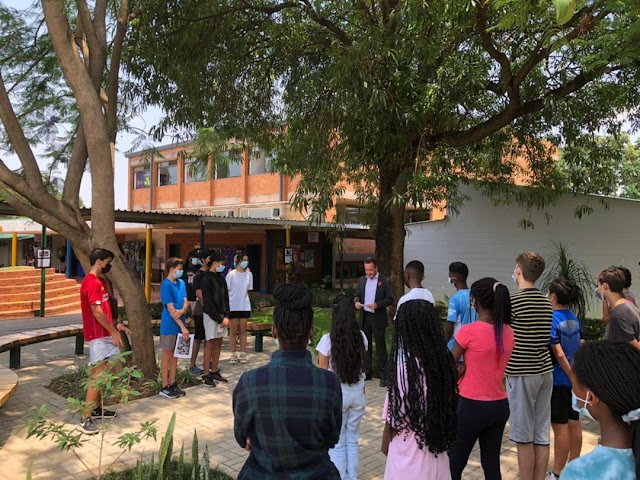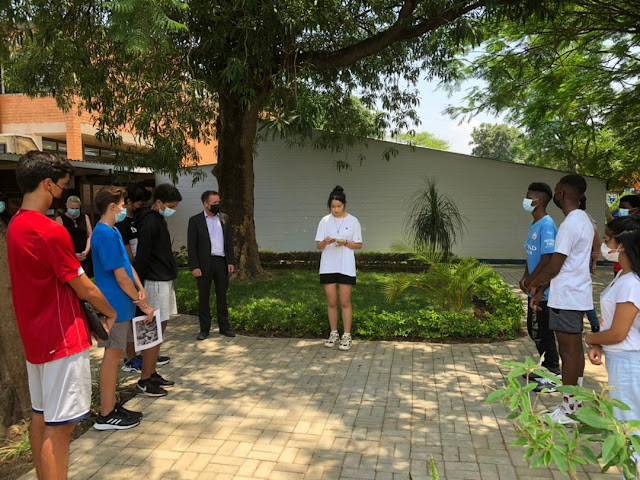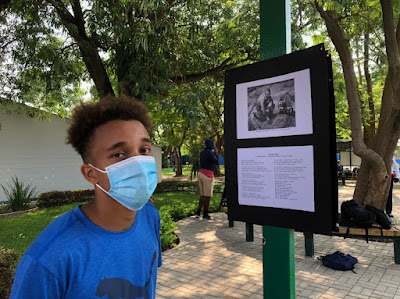For the 11 November IGCSE students were involved in an international project of Remembrance. We were joined in this reflection by two other schools: Lyng Hall School in the UK and Tagore International School, Vasant Vihar in India. It was an incredibly powerful experience to not only reflect on the philosophies that surround remembrance and conflict; but additionally to share with other communities and learn how their cultural perspectives shape their own understanding.
Each student was challenged to select a piece of art that responds to the question: Why should we remember WWI and WWII?
On Tuesday 9th November, a panel of international judges read all submissions from across all three countries. I am pleased to announce that the following students from ISL were selected as finalists:
1. Timuna Kalaluka
2. Sodal Saleban
3. Owain Holdway
4. Kriss Baskevics
5. Chiedza Madzima
6. Yoletta Shalumba
The following students from ISL were also shortlisted: Daniel Dudhia, Leah Kumitz, Masiliso Nakazwe, Filip Boltar, Rudo Banda, Yordan Gatev, Zahraa Patel.
On Remembrance Day, the finalists from each school had the opportunity to participate in an International Seminar. This was an inspiring discussion to be involved with – all students shared insightful observations and evaluative conclusions to some thought-provoking questions about the role History and Art play in our collective legacies. It was awe inspiring to listen to a group of young people debate and discuss some profound philosophies. We believe it to be the beginning of a number of collaborations.
The Art Speaks competition was an incredibly meaningful project which allowed our students to collaborate across continents and engage with some deeply challenging questions around war and conflict, and their legacy in the modern world. When we started this project, we set ourselves very ambitious goals. We wanted to provide a forum for students to engage with ideas around global remembrance. Our goal was to expand their intellectual horizons and help them develop a more complex understanding of the past.
‘What’s this? Do you want to understand my past?
It’s footprint in our today?
You are the ones who will become our legacy.’
This quote from Zeid Elmesalati’s poem I think perfectly encapsulates how well our students rose to the challenge we tasked them with. The students’ works provide us with a rich and diverse set of ideas and perspectives about remembrance. What’s more, in many ways they help us establish a dialogue with the past. ‘Poetry helps us to humanise the past’, I recall one student reflecting in the post-project seminar. What I would add is that it also helped us build bridges in the present by developing a greater awareness and deeper understanding of ourselves, our heritage and its global legacy.
Comments from the International Panel of Judges:
'I have always believed that Literature is a powerful medium to humanise the lives shaped by history, to unearth the individuals, moving beyond mere facts and statistics. This project was a beautiful way for students to explore complex ideas and consider how art (in different forms) can enable them to express their theories. Creatively they were able to deconstruct what values truly matter.'
Ms. Lisa Hagan, Director of English, UK
| The finalists' work was displayed in the UK, India and Zambia simultaneously. |
“The Art Speaks project was a unique opportunity to collaborate both across departments and across continents. It gave us an opportunity to link Historical facts with personal stories in the service of the important act of remembrance. The students responded in a variety of ways and I was very impressed with the thoughtful consideration they gave to the topic. Choosing the winners with the other judges was incredibly difficult because the quality of the work was so high. I was blown away by both the artistry and the depth of the responses. It was incredible to think that students so young could produce work of such skill and maturity.
I was also incredibly proud and impressed during the seminar which the winners took part in. The consideration they gave to the complex topics which many adults couldn’t comprehend was breath taking. It made me so proud of Lyng Hall and gave me hope for the future in the hands of these considerate young citizens.”
Mrs. Jane Burton, Director of Humanities
A virtual collection of the students’ responses can be found here, and for now the students will begin working on an international publication of the work from all three schools.

A small selection of some student works:
One of many by Timuna Kalaluka, International School of Lusaka, Zambia
He died in Stalingrad
Blood seeping into soil
Watering the plants of the motherland
And mixing with sweat and oil
The gears of war keep turning around
Greased by the tears of a mother’s despair
Her son dead at 26 from a Schmeisser round
As the scent of smoke and pain lingers in the air
Bodies dragged away
By comrades, and brothers-in-arms
As they place the corpses down to lay
Putting aside any past qualms
He lies in a graveyard
With Slavs, Kurds, Tatars, and Tajiks
As result of a psychopathic facade
The Molotov-Ribbentrop pact turned tragic
He answered the call of conscription
To defend the land given to his kin
To a war without jurisdiction
A fate his wife would be bereft in
The fuel of desperation
Motored the motivated defenders
Of fear they lacked the slightest inclination
As they faced the Nazi parties’ members
The onslaught continued until there was one
As the solitary soldier made a last stand
With honour and glory he was finally overrun
As his weapon fell from his hand
His eyes were glazed when the reinforcement came
But the tremor of footsteps gave him solace
In his final breath he had completed his aim
As the heroes' names were sung in a chorus
The people sing tales of sacrifice
Of grief and gratitude
Of a fight in which cowardice could not suffice
Of war never seen at such amplitude
The nations' greatest triumph
Its greatest loss
Maintaining its existence
At immense cost
The debt of their strength
On our shoulders weigh
Every year on November 11th
By honouring them, it we can repay
He was one of many soldiers
With one of many widows
One of many sacrifices
One of many heroes
One of many memories to keep alive.
By Owain Holdway, International School of Lusaka, Zambia
An autumn breeze lifts a wisp of loose grass high into the air
Four crosses side by side read the names of fallen men
Three women reap the rewards of the now ghost trodden field
A rejuvenation taking place during this Autumn yield.
A baby wails it’s earsplitting cry out into the expanse
The stumps of trees are bypassed, but it's caught on barbed wire fence
So many men did give their lives on this field now ghost trodden
So many sacrifices though none still are forgotten
Four years of hell on earth are gone but vividly remembered
Three women since nineteen-fourteen had lives always endangered
Their husbands both alive and passed know many fields ghost trodden
But sons and daughters after them will know of wars more modern
The sky, it seems to have calmed like just after a storm
It coats the fields, the trees, the towns that are tragically war torn
These broken homes and battlefields now lay home to ghosts
The fallen men and women we must remember most
The hues of blue pass over white and slanted crosses
A perpetual reminder of our many, many losses
Once home to living souls the field now holds just three women
All to reap the rewards that the field to them is giving
If not to respect the dead, respect the change they caused
Entire cultures, politics, ideas newly formed
The world will always know of fields infinitely ghost trodden
Let us hope that less blood is shed and those passed are not forgotten
So barbed wire, crosses, people all remind us still
That these wars affect most everyone not just those that they kill.
By Blessy Susan Mathew, Lyng Hall School, UK
When I came to consciousness,
All I saw were gravestones.
Each one stamped with the identity of
a nameless pawn.
Together they merged into a khaki green,
all facing a lonesome wire statue
With an unidentifiable face drained of thoughts.
I ask myself ‘why?’
It was as if there was no life left here
No one to talk to, no one to console
the bottomless pit in my mind
Never letting out a ‘I’m home!’ again.
Several months passed like this,
Several silent weeks went by
while I incessantly bombarded my surroundings
with what was left of my sanity.
I ask myself ‘why?’
However, on a certain day
my endless interrogation lead to the church bells ringing
Then an overwhelming presence stood there
People, how long ago has it been
since i last saw someone, walking and talking
For how long i don't know
They stayed close by, eyes closed and left as soon as they came.
All that is left was me, the gravestones and a wire statue.
This time a sombre expression was hung there
I understood all too well that expression
As I was feeling it too
I ask myself ‘why?’
As I stay in the darkness
Every year or so
The same people with the familiar faces visit
And went on 100 or so times after that
This time, a child, as small as the forest of gravestones
Behind him was the girl that visited me
For as long as my memory serves me
Smiling with a letter of a variety of fancy lettering
I ask myself ‘why?’
I would have started crying if i had tears to shed
Full of joyous moments was the letter addressed to me
However the heavens cried for me
As did the wire statue, leaking drops of rain
from where the eyes would have been
Why had it been so lonely all the time?
Why was this so unbearable?
Why did happiness only appear on a single day>
Why has this become my fate?
All that is left was me, the gravestones and sir wire statue
Without words did we communicate
A hint of concern flew by with the thought
Was this it?
Was this what I have to bear with for many more years
Talking to myself and a wire statue
I spent all this time, waiting for human connection
That I have resulted to madness
What even is this statue doing here?
Why is it here of all places?
Was it built here to mock the dead
Saying ‘you'll never be able to see what I see’
Or is it to guard us from the evil that lurks past the gates
Was it even built for us, the dead?
Was it to serve as a reminder of the living instead
To never forget why we, the dead, are here in the first place
Many gravestones stamped with the identities
of those buried below them
None of which I can recall
From when I gained consciousness to now.
x










Brilliant initiative!
ReplyDelete